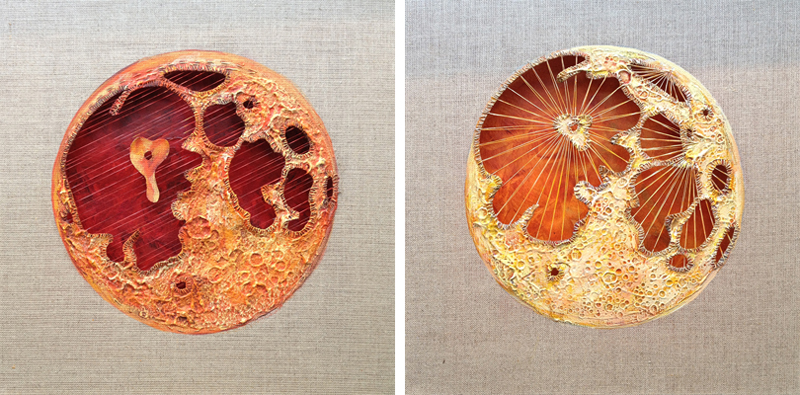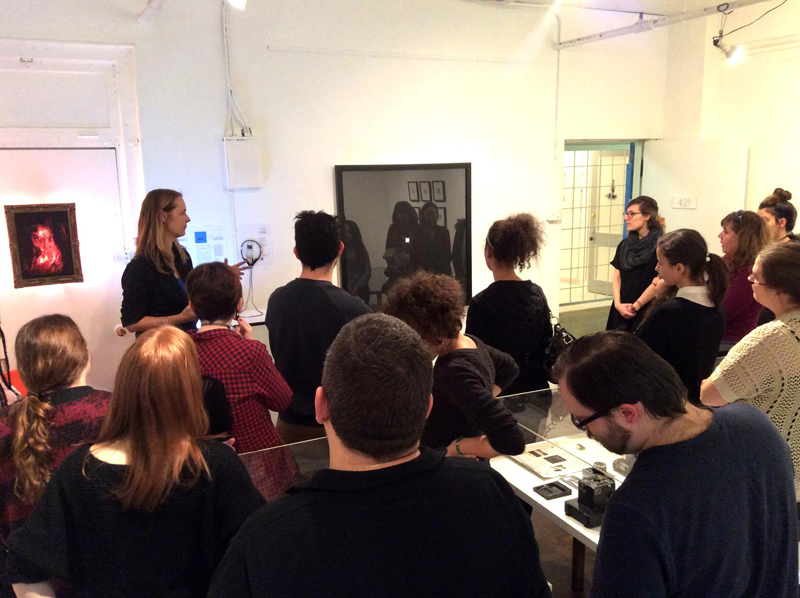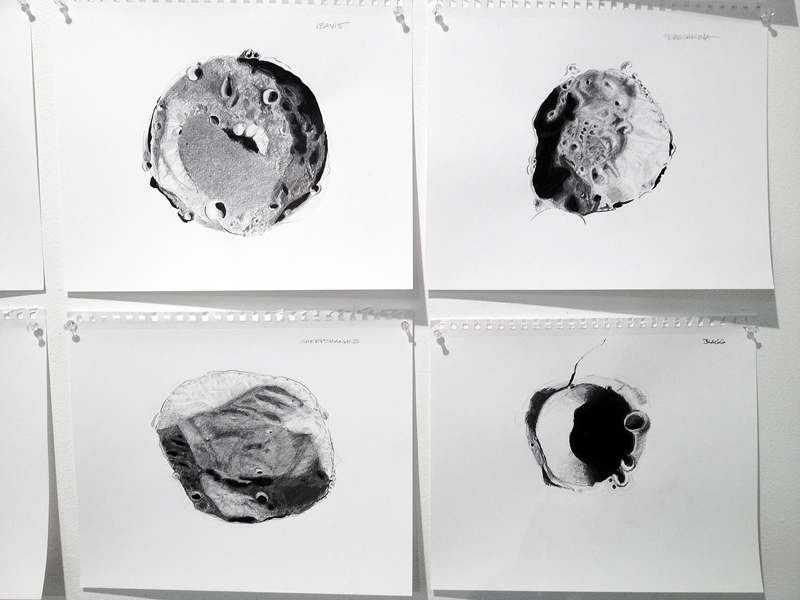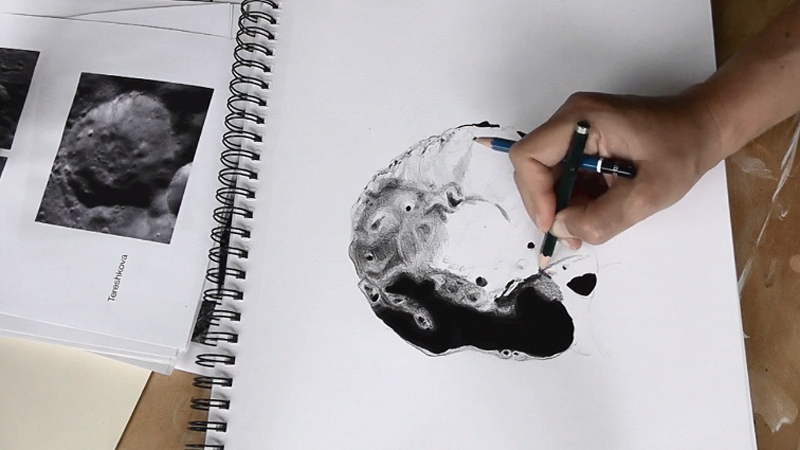- Published: Tuesday, November 24 2015 01:45
Art and Science
Last year, on a sweltering summer day in Montreal, about a dozen scientists and engineers from the International Space University (ISU) spilled into my gallery for a studio visit. Every summer the ISU organizes a three-month long Space Studies Program (SSP) which is hosted in major cities all around the world. Last year the ISU SSP was hosted by the HEC and UQAM right here in Montreal. One of the organizers had heard of my work, and she had made arrangements to bring SSP participants to my studio. I had chosen to present a survey of my work: an early painting series of the moons of Jupiter and Saturn, some examples of my "Naked Eye" star maps, and a few pieces from my “Somnium” series. I’ve given studio tours before, but this felt different. The ISU visitors were unusually engaged and asked insightful questions. We had a series of profound conversation, and I could see how meaningful it was for the group to see their work interpreted through the language of art. After this inspiring visit I was intrigued by the idea of making the science/art perspective a permanent component in my art gallery's mandate.

Visual Voice Gallery, clockwise from top left: Sarah Hatton - "Bee Works," Bill Finger - "Ground Control," Anna Biro - "Haptic Voices," Charles Lindsay "Carbon" (detail)
Since its inception in 2007, Visual Voice Gallery has presented mostly emerging artists. The guiding principles of the gallery's curatorial direction were: does this artist tell a story, and is the artist speaking in his or her own, unique voice? The selection process didn't favor a particular medium or aesthetic, but focused on the content of the artwork. After the ISU studio visit I wondered if it was possible to extend the tenet of my artistic practice to my gallery's mandate. Visual Voice Gallery would present art which deals with astronomy, physics, biology, chemistry, and math. It occurred to me that I already knew some artists working in this field. I sent out a few emails, and very soon I had a six-month program of science-focused, or “sciart,” exhibitions ready to go.

Eclipsed Moon, #1, #2, 2015, acrylic and nylon string on raw linen, 12" x 12" each
Sciart now informs everything I do. From the books I read to the workshops I teach, art and science are present side by side. I am interested in the intersection of art and science. What are the strategies employed in translating science into art, and how do ideas flow between the disciplines? How does scientific inquiry inspire artistic inquiry, and vice-versa? These questions are explored by the artists presenting at Visual Voice Gallery and in the workshops I lead, such as "Moon Mission" (see my previous post).

Bettina with students from Concordia University's Art Education program at Visual Voice Gallery (photo: Martin Lalonde)
I have also decided to return to student life to pursue a Master in Art Education at Concordia University. Here my research investigates how the art/science intersection can be explored in a Makerspace setting. Makerspaces are collaborative spaces where people meet to share knowledge and resources, and work on creative projects, mostly in the field of technological experimentation and idea prototyping. I'm currently transforming my studio space into an arts-themed Makerspace both for my own work and for the workshops I lead in my studio space. Besides the traditional art materials like paints, canvases, and mono printing equipment, there is also a 3D printer, a microscope (which can bee hooked up to a computer via a USB cable), thermochromic paints, and a bag of arduinos. This shift in perspective has also had an impact on my latest art project, where I'm complementing traditional drawing with 3D printing.

Women With Impact, 2015, acrylic and graphite on paper, installation view
The Women With Impact Series
Look at a Moon atlas, and you'll see a land populated with the names of philosophers, mathematicians, and astronomers. Great men like Plato, Aristarchus, Kepler, Galileo, Newton, Planck, have been immortalized by naming Moon craters after them, cementing their names in the firmament. But - what about the women? Out of the 1,605 named craters on the lunar surface, 27 are named after women - that is 1.7%. What is lost when the female presence is omitted?

Women With Impact, 2015, acrylic and graphite on paper, partial installation view

Women With Impact, 2015, acrylic and graphite on paper, partial installation view

Women With Impact, 2015, acrylic and graphite on paper, partial installation view
To highlight this issue, I decided to research the locations of the lunar craters named after women using data from NASA's Lunar Reconnaissance Orbiter. After capturing the most detailed images of the craters possible, I created a series of 27 drawings on paper, using acrylic paint and graphite. Each drawing is a portrait of a crater, accentuating topographical features, textures, and shadowing.
The next step is to print the craters with a 3D printer, to give them shape and presence. I am especially interested in this three-dimensional representation. A crater is essentially a void, a hollow in the regolith. The void echoes the underrepresentation of women in positions of power, in the scientific canon, and in history. The void also speaks to its opposite: each crater is a result of an impact, a shattering of the calm surface. The 27 women who made such an impact will be thrown into full relief with each sculpture. This process is currently in progress; I am working with a scientist at Washington University in St. Louis to translate the LIDAR data from NASA's Orbital Data Explorer into printable 3D files.

sketching Moon Craters, 2015, video still, 1 min 45 sec
As part of an art education pilot project I created a short video documenting myself in my studio while creating one of the Moon crater drawings. View it here:
https://www.flickr.com/photos/shootsfromthehip/19593504138/in/dateposted-public
There is a swelling tide of science-informed art, as evident in an increasing number of sci-art exhibitions, artist-in-residence programs at scientific research institutions, Masters programs, and residencies which investigate this field. It is an immense pleasure to be part of this burgeoning movement. I hope that with this series of blog posts I was able to inspire you to invite more artists into scientific research settings and together explore what happens when you fuse art and astronomy. Again, I would like to thank Astronomers Without Borders for inviting me to participate on their AstroArt blog as Astro Artist for the month of November. It's been an honor. Keep up the great work!
Further reading:
International Space University
http://www.isunet.edu
Visual Voice Gallery
http://www.visualvoicegallery.com
Concordia Uninversity / Art Education Program
https://www.concordia.ca/finearts/art-education.html
Maker movement
http://p2pfoundation.net/Maker_Movement
Lunar Reconnaissance Orbiter
http://lunar.gsfc.nasa.gov
---------








Comments